Sawdust are a universal natural insulation. With the help of this material, you can make not only the floors in the house warm, but also insulate the walls and roof. During the rapid development of technology, sawdust, as a heater, still does not lose its popularity. Our tips will help to properly complete the house warming sawdust with their own hands.
Content
How to use sawdust as a heater
Wood sawdust is a waste of sawing and processing wood, small chips and wood dust. Sawdust is used in private construction as the main material for making blocks. Or as the simplest and sufficiently high-quality natural insulation for dachas, country houses and various farm buildings. However, some sawdust (mound) is used very rarely. Sand, lime, copper sulphate, cement, various antiseptics and protective impregnations are mixed with sawdust - this is how practical and lasting warming mixtures are obtained.
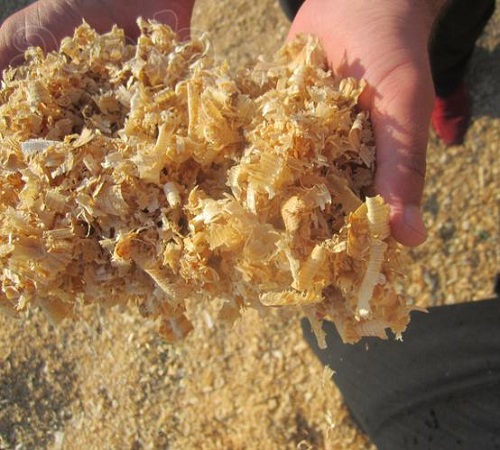
A layer of sawdust with the same width as mineral wool has the same practical and qualitative characteristics. This means that the material consumption will be approximately the same. But sawdust, this is a natural insulation, it retains all the properties and ecological compatibility of the tree. Sawdust, pre-mixed with the necessary components, can easily fall asleep in any hard-to-reach place. After that, the mixture is carefully compacted. Thus, a protective layer with excellent heat and sound insulation parameters is obtained.
It should be noted why sawdust, as a heater, should not be used in pure form without impurities. This material has two main drawbacks: dry sawdust is easily ignited and also is a favorite place of rodents. In addition, sawdust absorbs moisture very much. That is why lime, gypsum, copper sulfate and other components are mixed with sawdust - this mixture is difficult to ignite and indifferent to pests.
Heaters of sawdust
The construction industry based on sawdust has established the production of wood blocks, arbolite, sawdust pellets and alko-concrete. All these materials have two main important qualities: they have excellent thermal insulation properties and are included in the category of the cheapest construction materials.
sawdust pellets
This insulation is obtained by granulating sawdust with the addition of antiseptic, antiperene and glue from carboxymethylcellulose. Such granules (pellets) have low flammability and are unattractive to rodents. They are used as insulation in private and low-rise industrial construction.
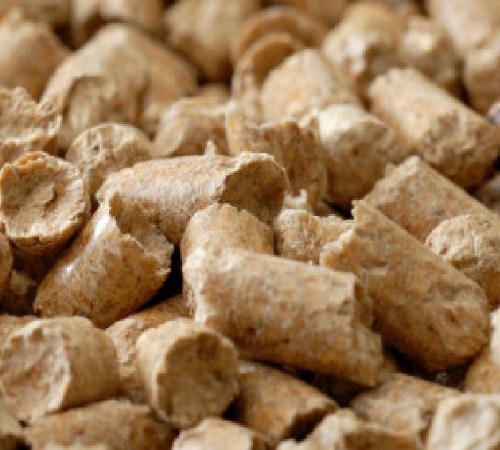
sawdust concrete
To obtain opilkobetona (sawdust concrete blocks) mix sawdust, preferably from coniferous species of wood, sand, lime and cement. In this mixture gradually and in small portions add water and constantly mix the mass. The main thing in this process is to calculate the amount of water correctly. Mix the mixture not only manually, but also with a concrete mixer. The resulting mixture is formed into blocks and dried (from 1 to 3 months). Such insulation is higher than the brick for thermal conductivity, it is fire resistant and comparable to breeze concrete in terms of performance. To insulate the walls, small flat blocks with a width of 10-20 cm are formed.

arbolite
Such a lightweight concrete is obtained by mixing organic filler, cement and chemical additives. As the main component (up to 90%) can be used sawdust, wood shavings or chips, straw, linen fire, chopped wood. To mineralize the mixture, calcium chloride (CaCl₂) is added. This ingredient promotes the correct process of solidification of the resulting mixture.
Arbolite is used as a heater block or plate, it has good resistance to stress, fire resistance and thermal conductivity. However, like all insulation with the use of sawdust, requires a device for high-quality waterproofing.
How to make a heater for walls of sawdust
The simplest way to insulate walls with sawdust is to fill them with walls when building a frame house. That is why, most often sawdust as a heater of walls is used in the construction of cottages.
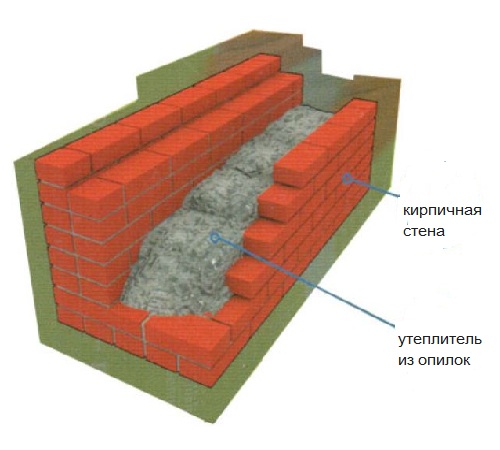
As a heater, large-grain sawdust or small chips obtained from sawing only wood are suitable. Sawdust and waste products of furniture production, remaining from the processing of particleboard, OSB, MDF can not be used, since they initially include binding materials, such wastes are too small (dusty) and are not environmentally friendly.
With this method, cement and lime are mixed with sawdust. Sometimes masters advised to add to the mixture a building gypsum, to obtain a monolithic structure. But the gypsum very quickly seizes, this mixture will have to be kneaded in small quantities, which will be very laborious and long in time. That's why they use cement, it will gradually take out excess moisture from sawdust and bind them, such insulation will become reliable and durable. Fresh sawdust should be allowed to "lie down" for a couple of months - they contain substances that prevent cement from binding to water.
Sawdust before making the mixture must be impregnated with an antiseptic to prevent decay. It can be copper sulfate or boric acid. You can add an antiseptic drug to the water to make the mixture. To discourage small rodents, sawdust is mixed with lime, as a heater is a sufficiently high-quality product, while pests are indifferent to it.
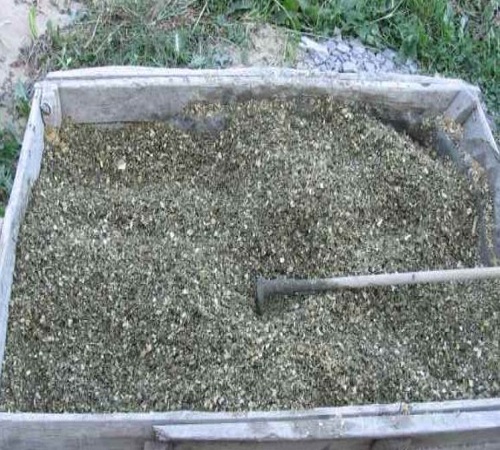
The exact proportion of the mixture in which sawdust with cement is used as a heater is difficult to determine, the parameters depend on the fraction and humidity of the sawdust itself. On average, you will need:
- Sawdust - 10 buckets.
- Cement - 1 bucket.
- Lime - 0,5-1 bucket.
- Water - from 5 liters.
All the dry ingredients of the mixture are mixed, then water is added. It is very important to correctly calculate the right amount of water, it can be added with a watering can. If you take a small amount of the mixture in your hand and squeeze, then the ball should be elastic, do not crumble, but the water should not be wrung out at the same time.
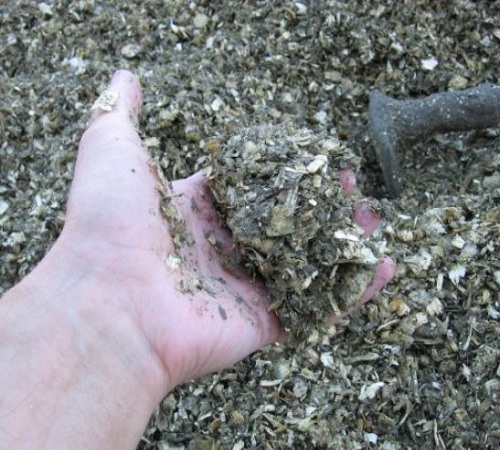
The mixture is poured into the frame walls in portions and compacted. After each serving, a separation board must be installed, after which the process is repeated anew. The action of the warming mixture is based on the fact that when tamping, the moisture contained in the sawdust "grasps" the cement. After drying, a layer of insulation with excellent thermal insulation parameters is obtained.
The thickness of insulation from sawdust for a house is 25-30 cm. If it is necessary to insulate the country house, which will be used very rarely in winter, then the thickness of the layer in walls of 15 cm and in the slabs of 20-25 cm is sufficient. All the places of passage of the chimney pipes should be secured with fireproof materials. Cables for wiring are enclosed in metal pipes. All fire-hazardous places (switches, sockets) should be equipped with non-combustible materials.
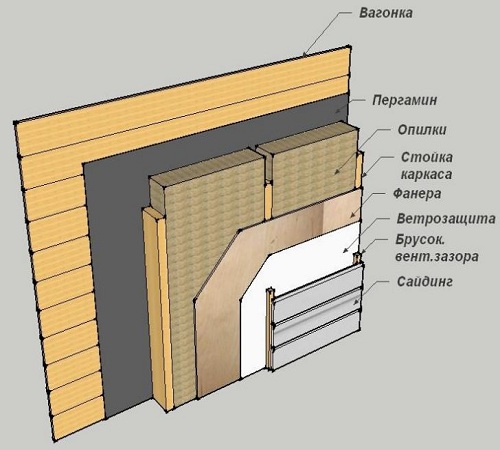
Attention! It is not necessary to arrange a vapor barrier of walls with a heater from sawdust. The walls must "breathe", that is, be vapor-permeable.
Sawdust for ceiling insulation
To the question of the insulation of the ceiling should be approached very carefully, since about 20% of the heat is lost through the ceiling. Thus sawdust as a heater of a ceiling should be cured, dry, on them there should not be a mildew and a mold. There are several options for making insulation for the ceiling. For example, you can make a mixture with the use of cement, and you can apply clay.
insulation from sawdust with the addition of cement
What would be correct to make a heater from sawdust with their own hands with cement will require the following work:
- The rough ceiling must be sent by pergamon or other waterproofing material. In this case, the ceiling beams, like all wooden structures in the house, must be treated with flame retardant emulsions.
- Mix in a ratio of 10: 1 sawdust and cement. After this, add water so that the mixture is slightly moist (1-1.5 buckets of water). After mixing the mixture, the sawdust looks greased in the cement.
- The resulting mixture is laid between the beams over the surface of the floors, then rammed. The thickness of the insulation layer laid between the beams is about 25 cm. The special secret of such a heat-insulating layer is a good ramming of the mixture.
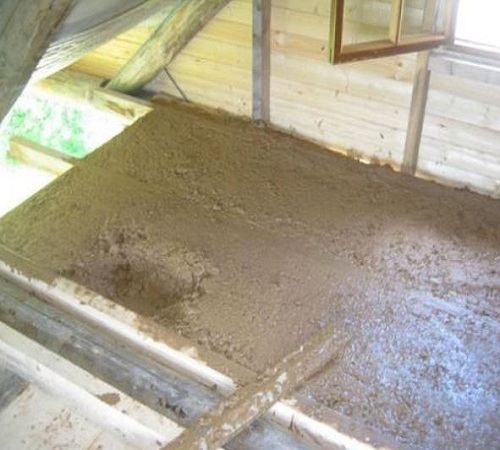
Work should be carried out in early summer, which would allow the layer of insulation to dry out. Sawdust, used for the ceiling, can be both small and large. However, it should be borne in mind that the smaller the sawdust, the more water is required, therefore, the mixture will be more viscous. To grasp it will require more cement.
Attention! The more cement is added to the warming mixture of sawdust, the weaker its thermal insulation parameters.
insulation from sawdust with the addition of clay
The usual clay and sawdust as a heater are used for a long time, this mixture has excellent quality characteristics. The insulation of the ceiling is carried out in series:
- Before starting work, the ceiling overlap is covered with a waterproofing film, since the mixture will be sufficiently liquid.
- It is necessary to prepare clay water: 5 clay buckets are poured with water until a creamy consistency is obtained. The concrete mixer is filled with 2-3 buckets of clay water and the filings are covered. Stir to a thick, viscous mass.
- The mixture is applied to the ceiling evenly with a layer of 10 cm, is smoothed and tamped. It will take about a month to dry. In this case, the surface may crack slightly, - it can be rubbed with clay solution. On top it is recommended to lay boards for free advancement in the attic.
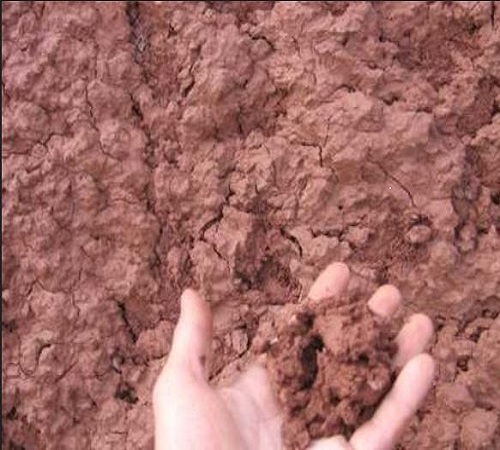
Warming with sawdust floor
Here, immediately it is worth making a reservation. Warming of the floor with sawdust is somewhat different from other methods, as floors are required to be washed constantly, and sawdust as a floor heater very strongly impregnate water. Therefore, you should take care of their reliable protection, while not forgetting that the sawdust mixture should be constantly dried ("breathe"). As a protective film, it is best to use pergamine. And it fits both under the layer of the mix of sawdust, and on it, directly under the boards of the finishing floor.
Based on sawdust produced ecowool. This is a cheap enough insulation based on natural ingredients. It includes all the same cement and lime. Sand can be added to them. It is possible to apply such a heat-insulating layer manually or by means of a special apparatus. Such a mechanical method allows you to lay ecowool both dry and moistened way.
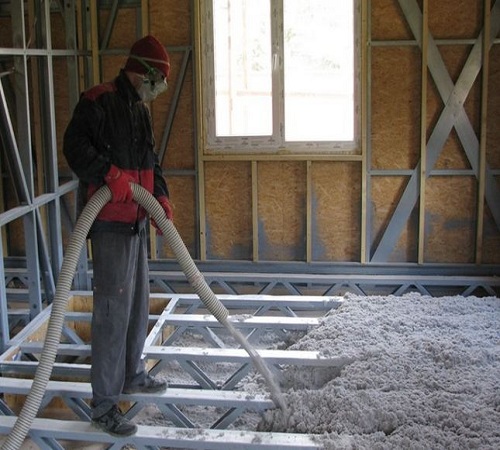
Ecowat is injected directly into the floor space between the lags. Usually such work is entrusted to specialists, as there is no sense in buying an expensive unit for one-time use.
Naturally, the usual sawdust mixture of cement and lime can be laid as a heater itself. The material consumption in this case will increase by 40%.
The process of floor insulation takes place in the following sequence:
- If necessary, partial or complete dismantling of the floor is carried out. All wooden beams, ceilings, bars are treated with a flame retardant emulsion.
- To the beams, a rough floor is assembled from any low-grade or secondary wood. All wood should be treated with fire retardant and antiseptic.
- Lay the boards or shields on the rough floor. On this auxiliary base spread a covering vapor-permeable material (parchment).
- Obtained from the sawdust mixture, pour a layer of about 10 cm.
- The installed insulation must dry. In this case, the insulation will settle 3-4 cm.
- After the drying of the heater, the parchment is laid and the finishing floor is mounted.
Insulation of sawdust with own hands - this is an environmentally friendly product, which is why, despite the huge variety of modern building materials, it enjoys attention and popularity. With all the norms of production and fire safety, the house with such a heater will be warm, dry and environmentally friendly.



















